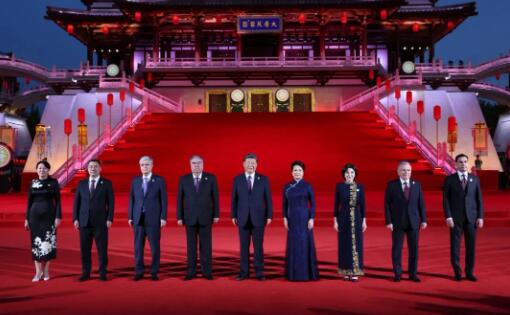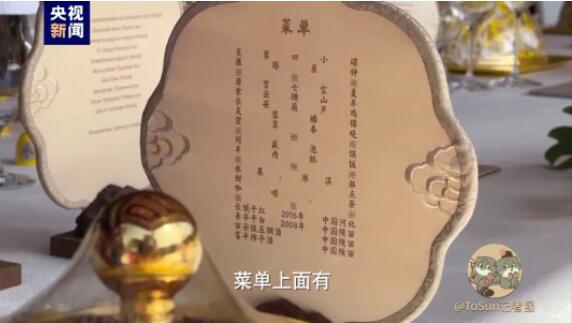那些出现在中亚峰会上的陕西元素,你知道它们的故事吗?
阅读量:

长相思,在长安。
这座在唐帝国鼎盛时期,拥有100多万人口的国际都市,曾让无数人魂牵梦绕。而近日,因为一场重大的外交活动,让古城西安又一次迎来它的高光时刻。
5月18日至19日,习近平主席分别同中亚五国元首会谈,并在西安大唐芙蓉园为远道而来的贵宾举行了独具特色的欢迎仪式和欢迎宴会。
一路别具匠心的活动安排,传递了中国与中亚团结友好、共创未来的深意,也展现了璀璨夺目的陕西文化,让我们跟随峰会的节奏,共同探寻一场文化之旅。
古丝绸之路的起点
西安,缘何成为此次元首外交的重要舞台?
时光回溯到2100多年前,中国汉代张骞正是从这里出发,两次出使中亚,开启了中国同中亚国家友好交往的大门,开辟出一条横贯东西、连接欧亚的丝绸之路。
前往西域的道路打通之后,汉朝与西域各国建立了良好的外交关系。葡萄、石榴、胡瓜等随着西域驼队的脚步传入汉朝,而汉朝的丝绸、茶叶等也源源不断地运往西域,甚至远销波斯、罗马,这条遍布商旅的道路也被人们称为“丝绸之路”。
Once there was a direct route to the Western Regions, the Han Dynasty was able to establish good relations with western states. Camel caravans brought grapes, pomegranates and cucumbers from the west, while silk and tea of the Han were transported to the Western Regions, and even to the Persian Empire and Roman Empire. This passage, bustling with merchants from all directions, was known as the Silk Road.
丝绸之路以如今陕西省西安市为起点,经河西走廊到新疆,再由新疆到中亚、西亚,最终抵达地中海各国。这条连接了东方和西方、蜿蜒曲折的道路,成为东西方文明沟通交流的桥梁和纽带,增强了中华文明与世界文明的交往和联系,为文明的互鉴发展发挥了重要作用。
The Silk Road’s starting point was what is now Xi’an, Shaanxi. It extended along the Hexi Corridor to today’s Xinjiang Uygur autonomous region, Central Asia and West Asia, and finally to the Mediterranean. This winding road, a connector between the East and the West, became a bridge between the great civilizations, enhancing the interaction between China and the rest of the world and playing an important role in the mutual learning and development of human society.
——《陕西:中华文明的肇始之地》
丝绸之路 中西文化的桥梁
昔日丝绸之路的起点,也正是当今中国和中亚经贸往来的枢纽。
在西安为中亚五国元首举行欢迎仪式,体现出中国期待与中亚五国继往开来、加强合作的愿望。
热情洋溢的陕西腰鼓
在迎接哈萨克斯坦总统的现场,当地民众以质朴热烈的民间艺术表演——热情的腰鼓、欢快的秧歌,欢迎这位来自中亚国家的贵宾。
热闹的鼓声,舞动的红色腰带,向远道而来的中亚朋友表示热烈欢迎,也为祖国的繁荣富强呐喊欢呼。
作为极具民俗风格和地域特色的安塞腰鼓,有2000多年的悠久历史。在70多年前,鼓声也曾在天安门前飞扬,歌颂了新中国的精神面貌,展现了新时代中国人民的精气神。
1951 年国庆来临之际,曹怀荣与邻村二十多个鼓手商量去天安门广场打腰鼓献礼。当时,曹怀荣动员大家说:“毛主席带领人民取得了革命的胜利,过上了好日子,哪怕是走,也要把腰鼓打到天安门!”在曹怀荣的鼓舞下,所有鼓手备好干粮,开始了长途跋涉的征程。半路上,不断有人因体力不支而病倒,不得不放弃前进。最后,曹怀荣和十几个鼓手凭借着坚强的意志,终于来到了天安门广场。
In 1951, as National Day approached, Cao Huairong and more than 20 other Ansai Waist-Drum dancers from neighboring villages discussed going to Tian’anmen Square to perform. Huairong rallied everyone, saying, “Chairman Mao has led the people to victory in the revolution and to a better life. We have to take waist-drum dancing to Tian’anmen Square, even if it means we have to go there on foot!” Deeply inspired, all the drummers packed and started the long journey. On the way, many people became physically exhausted, fell ill and had to stop. In the end, Huairong and a dozen others persevered and arrived at their destination.
当看到毛主席等领导人出现在主席台上时,曹怀荣身上的疲惫一扫而光。随着锣鼓齐鸣,这些头系羊毛巾、身着素衣的汉子们两手执槌,跟随领头鼓手的哨音变换动作和队形,时而散开,时而聚拢,动作威猛刚烈、流畅飘逸,令人叫绝。后来,每当有人问起他这次经历,曹怀荣总会不厌其烦地说:“虽然苦,但这一切都值了。”
When they saw Chairman Mao and other leaders at the podium, their fatigue was swept away. With the drums and gongs sounding in unison, the men, drumsticks in hand, followed the whistle of the lead performer and continually shifted their formation, sometimes spreading out, sometimes gathering together, in powerful movements. Whenever he was asked about this experience, Huairong would always say, “It was hard for sure, but it was all worth it.”
——《陕西:中华文明的肇始之地》
安塞腰鼓 天安门前打腰鼓
历史车轮滚滚向前,关于安塞腰鼓的故事还会继续,不管在什么年代,它一直都是中华民族热烈的生命之舞。
羊肉泡馍里的深重情义
半开放式国宴也细节满满,除了摆台上代表中国和中亚各国历史文化背景的精致摆件,陕西味道也成为国宴主角,芙蓉国四小蝶、同盛泡馍、羊肉抓饭、富平柿子酒......

除了在国宴上成为招待各国元首的佳肴,作为闻名遐迩的一道美食,羊肉泡馍也广泛出现在西安的大街小巷。
哈萨克斯坦大使馆的工作人员就对这道西安特色美食留下了深刻印象。吃一碗热腾腾的羊肉泡馍,品的是西北千年的风土人情,哪怕在遥远的年代,这碗羊汤也承载着人与人之间的深重情义。
赵匡胤小心翼翼地走到老伯跟前,问老伯是否可以给自己打一碗。老伯看着落魄的赵匡胤,心生怜悯,便给他打了一碗滚烫的羊肉汤。但只有汤,没有干粮也是吃不饱的。于是,赵匡胤便把两个干饼子掰碎泡入,硬邦邦的饼子被热乎的羊汤泡得软乎乎的,像极了美味佳肴。
Zhao Kuangyin cautiously approached the old man and asked if he could have a bowl. The old man took pity on Zhao and was happy to let him have a bowl of the broth. The soup, though delicious, was not very filling, so Zhao Kuangyin tore his bread and ripped it into small pieces, soaking them in the broth. Softened in the soup, it was transformed into a hearty meal.
赵匡胤饿极了,狼吞虎咽地将整碗羊肉汤一扫而光。这一碗热乎的羊肉汤下肚后,赵匡胤饥寒全无、精神大振,再次踏上了征程。
Zhao Kuangyin was so hungry that he had polished off the whole bowl of mutton broth. With hunger and cold dispelled and his spirits lifted, Zhao Kuangyin set off again.
陈桥兵变后,赵匡胤黄袍加身,登基为帝,建立了宋朝,结束了五代乱世。
After the Chenqiao Mutiny, Zhao Kuangyin was draped in imperial yel-low robes by his troops, thus establishing the Song Dynasty and bringing the chaos of the Five Dynasties to an end.
虽然当上了皇帝,但赵匡胤依然对当年吃的那一碗羊肉汤念念不忘,于是征集各地的大厨仿制。可无论大厨们怎样精心制作,赵匡胤都不甚满意,总觉得差些味道。后来,有一位大厨将面饼掰碎,撒入肉汤中。这次,赵匡胤终于吃出了当年的滋味,下令褒奖,并把这道美食列入宫廷菜谱。
Zhao Kuangyin, then Emperor Taizu, never forgot the mutton broth he had been given all those years before. He asked chefs from all over the realm to try to recreate it for him. However, no matter how hard the chefs tried, Zhao Kuangyin was never quite satisfied and always felt that it lacked something. On one occasion, a chef sprinkled crumbs of bread into the broth. Finally, Zhao Kuangyin tasted the flavor he remembered. He rewarded the chef and ordered the dish to be included on the court menu. It became known as “Mutton Paomo,” meaning mutton broth with pieces of bread.
——《陕西:中华文明的肇始之地》
泡馍大碗卖 情意在碗中
陕西是一片神奇的土地,在大明宫残破的城墙旁,你能读懂历史的厚重;在不夜城繁华的盛景里,你能窥见大唐的辉煌;在古丝路庄严的遗址上,你能聆听驼铃的悠远回响.....这里上演了太多波澜壮阔的史诗,留下了中华文明的诸多精神标识。
如今,中国-中亚峰会大幕已经拉开。从古丝绸之路的起点携手再出发,中国-中亚合作未来可期。在这片古老的土地上,正在抒写人类命运共同体的全新篇章。
文章英语翻译来自:
《陕西:中华文明的肇始之地》
